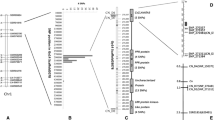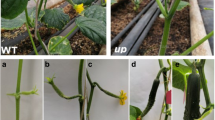Abstract
Key message
Candidate genes associated with in vitro regeneration were identified in cucumber.
Abstract
The ability to regenerate shoots or whole plants from differentiated plant tissues is essential for plant transformation. In cucumber (Cucumis sativus L.), regeneration ability varies considerably across accessions, but the genetic mechanism has not yet been demonstrated. In the present study, 148 recombinant inbred lines and a core collection were examined to identify candidate genes involved in cucumber regeneration. Four QTL for cotyledon regeneration that explained 9.7–16.6% of the phenotypic variation in regeneration were identified on cucumber chromosomes 1, 3, and 6. The loci Fcrms1.1 and Fcrms+1.1 were consistently detected in the same genetic interval on two regeneration media. A genome-wide association study revealed 18 SNPs (− log(p) > 5) significantly associated with cotyledon regeneration. Three candidate genes in this region were identified. RT-PCR analyses revealed that Csa1G642540 was significantly more highly expressed in genotypes with high cotyledon regeneration rates than in those with low regeneration. The Csa1G642540 CDS driven by its native promoter was transformed into cucumber line 9110Gt; molecular analyses showed that the T-DNA had integrated into the genomes of 8.6% of regenerated plantlets. The seeds from T0 plants expressing Csa1G642540 were tested for regeneration from cotyledon explants, and the segregate ratio in regeneration frequency is 3:1. The AT3G44110.1, the homologue gene of Csa1G642540 in Arabidopsis, has been reported as PM H+-ATPase activity regulation, integrating flowering signals and enlarging meristem function. These results demonstrate that Csa1G642540 might play an important role in regeneration in cucumber and could serve as a selectable marker for regeneration from cotyledons.




Similar content being viewed by others
References
Altschul SF, Wootton JC, Gertz EM, Agarwala R, Morgulis A, Schäffer AA et al (2005) Protein database searches using compositionally adjusted substitution matrices. FEBS J 272(20):5101–5109
Armstrong CL, Romero-Severson J, Hodges TK (1992) Improved tissue culture response of an elite maize inbred through backcross breeding, and identification of chromosomal regions important for regeneration by RFLP analysis. Theor Appl Genet 84:755–762
Banno H, Ikeda Y, Niu QW, Chua NH (2001) Overexpression of Arabidopsis ESR1 induces initiation of shoot regeneration. Plant Cell 13:2609–2618
Barghetti A, Sjögren L, Floris M, Paredes EB, Wenkel S, Brodersen P (2017) Heat-shock protein 40 is the key farnesylation target in meristem size control, abscisic acid signaling, and drought resistance. Genes Dev 31(22):2282–2295
Barrett JC, Fry B, Maller J, Daly MJ (2005) Haploview: analysis and visualization of LD and haplotype maps. Bioinformatics 21:263–265
Charles LS, Blair B, William S (1987) Membrane-directed effects of the plant hormones abscisic acid, indole-3-acetic acid and 2,4-dichlorophenoxyacetic acid. Biochem Biophys Res Commun 143(3):1085–1091
Galland R, Randoux B, Vasseur J, Hilbert JL (2001) A glutathione-S-transferase cDNA identified by mRNA differential display is upregulated during somatic embryogenesis in Cichorium. Biochim Biophys Acta Gene Struct Expr 1522:212–216
Gomez KA, Gomez AA (1976) Statistical procedures for agricultural research with emphasis of rice. International Rice Research Institute, Los Baños
Gruszczyńska A, Rakoczy-Trojanowska M (2011) Expression analysis of somatic embryogenesis-related SERK, LEC1, VP1 and NiR ortologues in rye (Secale cereale L.). J Appl Genet 52:1–8
Haberlandt M (1902) Die literaturen der perser. Semiten und Türken, Goschen
Hansen LN, Ortiz R, Andersen SB (1999) Genetic analysis of protoplast regeneration ability in Brassica oleracea. Plant Cell Tissue Organ Cult 58(2):127–132
Hecht V, Vielle-Calzada JP, Hartog MV, Schmidt ED, Boutilier K, Grossniklaus U, de Vries SC (2001) The Arabidopsis SOMATIC EMBRYOGENESIS RECEPTOR KINASE 1 gene is expressed in developing ovules and embryos and enhances embryogenic competence in culture. Plant Physiol 127:803–816
Hellens R, Mullineaux Klee H (2000) Technical focus: a guide to Agrobacterium binary Ti vectors. Trends Plant Sci 5:446–451
Hewitt EJ (1975) Assimilatory nitrate-nitrite reduction. Ann Rev Plant Physiol 26(4):73–100
Hu H, Xiong L, Yang Y (2005) Rice SERK1 gene positively regulates somatic embryogenesis of cultured cell and host defense response against fungal infection. Planta 222:107–117
Huang SW, Li RQ, Zhang ZH, Li L, Gu XF, Fan W et al (2009) The genome of the cucumber, Cucumis sativus L. Nat Genet 41:1275–1281
Komatsuda T, Annaka T, Oka S (1993) Genetic mapping of a quantitative trait locus (QTL) that enhances the shoot differentiation rate in Hordeum vulgare L. Theor Appl Genet 86:713–720
Lander ES, Botstein D (1989) Mapping Mendelian factors underlying quantitative traits using RFLP linkage maps. Genetics 121:185–199
Lehmann EL, D’Abrera HJM (1975) Nonparametrics. McGraw-Hill, New York
Li JX, Li JW, Guimin GE (2008) In vitro culture and plantlet regeneration from cotyledon of Cucumis sativus L. J Changjiang Veg 1:44–47
Li Z, Zhang ZH, Yan PC, Huang SW, Fei ZJ, Lin K (2011) RNA-Seq improves annotation of protein-coding genes in the cucumber genome. BMC Genom 12(1):540
Li SJ, Yan S, Wang AH, Zou GH, Huang XH, Han B et al (2013a) Identification of QTLs associated with tissue culture response through sequencing-based genotyping of RILs derived from 93-11 × Nipponbare in rice (Oryza sativa). Plant Cell Rep 32:103–116
Li YH, Wen CL, Weng YQ (2013b) Fine mapping of the pleiotropic locus B for black spine and orange mature fruit color in cucumber identifies a 50 kb region containing a R2R3-MYB transcription factor. Theor Appl Genet 126:2187–2196
Lotan T, Ohto M, Yee KM, West MA, Lo R, Kwong RW, Yamagishi K, Fischer RL, Goldberg RB, Harada JJ (1998) Arabidopsis LEAFY COTYLEDON 1 is sufficient to induce embryo development in vegetative cells. Cell 93:1195–1205
Lv J, Qi JJ, Shi QX, Shen D, Zhang SP, Shao GJ et al. (2012) Genetic diversity and population structure of cucumber (cucumis sativus L.). Plos One 7(10):e46919
Mano Y, Takahashi H, Sato K, Takeda K (1996) Mapping genes for callus growth and shoot regeneration in barley (Hordeum vulgare L.). Jpn J Breed 46:137–142
Murashige T, Skoog F (1962) A revised medium for rapid growth bioassays with tobacco tissue cultures. Physiol Plant 15:473–497
Nishimura A, Ashikari M, Lin S, Takashi T, Angeles ER, Yamamoto T et al (2005) Isolation of a rice regeneration quantitative trait loci gene and its application to transformation systems. Proc Natl Acad Sci USA 102:11940–11944
Nolan KE, Kurdyukov S, Rose RJ (2009) Expression of the SOMATIC EMBRYOGENESIS RECEPTOR-LIKE KINASE1 (SERK1) gene is associated with developmental change in the life cycle of the model legume Medicago truncatula. J Exp Bot 60:1759–1771
Ozawa K, Kawahigashi H (2006) Positional cloning of the nitrite reductase gene associated with good growth and regeneration ability of calli and establishment of a new selection system for Agrobacterium-mediated transformation in rice (Oryza sativa L.). Plant Sci 170:384–393
Qi JJ, Liu X, Shen D, Miao H, Xie BY, Li XX et al (2013) A genomic variation map provides insights into the genetic basis of cucumber domestication and diversity. Nat Genet 45:1510–1515
Šamaj J, Bobák M, Blehová A, Pret’Ová A (2005) Importance of cytoskeleton and cell wall in somatic embryogenesis. Springer, Berlin
Sauter M, von Wiegen P, Lörz H, Kranz E (1998) Cell cycle regulatory genes from maize are differentially controlled during fertilization and first embryonic cell division. Sex Plant Reprod 11:41–48
Schiantarelli E, Adela P, Candela M (2001) Use of recombinant inbred lines (RILs) to identify, locate and map major genes and quantitative trait loci involved with in vitro regeneration ability in Arabidopsis thaliana. Theor Appl Genet 102:335–341
Schmidt ED, Guzzo F, Toonen MA, de Vries SC (1997) A leucine-rich repeat containing receptor-like kinase marks somatic plant cells competent to form embryos. Development 124:2049–2062
Seo MS, Jin M, Lee SS, Kwon SJ, Mun JH, Park BS et al (2013) Mapping quantitative trait loci for tissue culture response in VCS3M-DH population of Brassica rapa. Plant Cell Rep 32:1251–1261
Shen LS, Kang YGG, Liu L, Yu H (2011) The j-domain protein j3 mediates the integration of flowering signals in Arabidopsis. Plant Cell 23(4):499–514
Singla B, Khurana J, Khurana P (2008) Characterization of three somatic embryogenesis receptor kinase genes from wheat, Triticum aestivum. Plant Cell Rep 27:833–843
Taylor TE, Veilleux RE (1992) Inheritance of competencies for leaf disc regeneration, anther culture, and protoplast culture in Solanum phureja and correlations among them. Plant Cell Tissue Organ Cult 31:95–103
Torp AM, Hansen AL, Andersen SB (2001) Chromosomal regions associated with green plant regeneration in wheat (Triticum aestivum L.) anther culture. Euphytica 119:377–387
Tromas A, Paponov I, Perrot-Rechenmann C (2010) Auxin binding protein: 1. Functional and evolutionary aspects. Trends Plant Sci 15:436–446
Trujillomoya C, Gisbert C, Vilanova S, Nuez F (2011) Localization of QTLs for in vitro plant regeneration in tomato. BMC Plant Biol 11:140
Wang Y, Gu XF, Zhang SP, Miao H, Chen GH, Xie BY (2014) Transformation of RNAi vector in cucumber (Cucumis sativus L.) in vitro by Agrobacterium tumefaciens-mediated transfection. Chin Bull Bot 49:183–189
Wehner TC, Locy RD (1981) In vitro adventitious shoot and root formation of cultivars and lines of Cucumis sativus L. Hort Sci 16:759–760
Yakandawala N, Jordan MC (2008) Isolation of a somatic embryogenesis receptor kinase gene from wheat and assessment of its role in transformation. In: Appels R, Eastwood R, Lagudah E, Langridge P, Mackay M, McIntyre L, Sharp P (eds) Proceedings of 11th international wheat genetics symposium. Sydney University Press, Sydney, pp 610–612
Yang YQ, Qin YX, Xie CG, Zhao FY, Zhao JF, Liu DF et al (2010) The Arabidopsis chaperone j3 regulates the plasma membrane h+-atpase through interaction with the pks5 kinase. Plant Cell 22(4):1313–1332
Zakizadeh H, Stummann B, Lütken H, Müller R (2010) Isolation and characterization of four somatic embryogenesis receptor-like kinase (RhSERK) genes from miniature potted rose (Rosa hybrida cv. Linda). Plant Cell Tissue Organ Cult 101:331–338
Zhang S, Wong L, Meng L, Lemaux PG (2002) Similarity of expression patterns of knotted1 and ZmLEC1 during somatic and zygotic embryogenesis in maize (Zea mays L.). Planta 215:191–194
Zhang S, Liu X, Lin Y, Xie G, Fu F, Liu H et al (2011) Characterization of a ZmSERK gene and its relationship to somatic embryogenesis in a maize culture. Plant Cell Tissue Organ Cult 105:29–37
Zhou Q, Miao H, Li S, Zhang SP, Wang Y, Zhang ZH et al (2015) A sequencing-based linkage map enables precise localization of Mendelian genes and quantitative trait loci in cucumber. Mol Plant 8:961–963
Zubko E, Adams CJ, Macháèková I, Malbeck J, Scollan C, Meyer P (2002) Activation tagging identifies a gene from Petunia hybrida responsible for the production of active cytokinins in plants. Plant J 29:797–808
Zuo J, Niu Q, Frugis G, Chua NH (2002) The WUSCHEL gene promotes vegetative-to-embryonic transition in Arabidopsis. Plant J 30:349–359
Acknowledgements
This work was funded by Grants from the National Natural Science Foundation of China (NSFC: 31201626).
Author information
Authors and Affiliations
Contributions
YW performed the experiments and collected the data. YW, QZ, and GZ performed the bioinformatics analyses. SW, YM, HM, and SZ provided experimental assistance. SH and ZZ provided advice regarding research design. XG provided critical comments on the manuscript. All authors approved the final version of the manuscript.
Corresponding authors
Ethics declarations
Conflict of interest
The authors declare that they have no conflict of interest regarding this study.
Ethical standards
This work complies with the current laws of China.
Additional information
Communicated by Heiko C. Becker.
Electronic supplementary material
Below is the link to the electronic supplementary material.
Rights and permissions
About this article
Cite this article
Wang, Y., Zhou, Q., Zhu, G. et al. Genetic analysis and identification of a candidate gene associated with in vitro regeneration ability of cucumber. Theor Appl Genet 131, 2663–2675 (2018). https://doi.org/10.1007/s00122-018-3182-7
Received:
Accepted:
Published:
Issue Date:
DOI: https://doi.org/10.1007/s00122-018-3182-7




